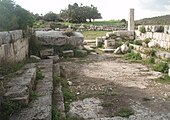Khirbet Samara
 The Samaritan synagogue at Khirbet Samara | |
| Location | West Bank |
|---|---|
| Coordinates | 32°16′45″N 35°06′54″E / 32.279194°N 35.11495°E |
| Type | settlement, synagogue |
| Area | 30 acres |
| History | |
| Periods | Roman to Byzantine period |
| Cultures | Samaritan |
| Site notes | |
| Excavation dates | 1991-2 |
| Archaeologists | Yitzhak Magen |
| Condition | In ruins |
Khirbet Samara (
The site was first surveyed by the Palestine Exploration Fund in the late 19th century, and was then mistakenly identified as a church.[1] In excavations conducted by Israeli archeologist Yitzhak Magen in 1991–1992, the structure on the eastern edge of the site was identified as a Samaritan synagogue.[2][3] In addition, a mikveh,[4] a cistern, an arched gate, burial caves and public structures were found at the site.
Samaritan synagogue
The Samaritan synagogue was built in the 4th century CE.[2][5] An imposing building built in an east–west direction, it faces Mount Gerizim, the holiest site in Samaritanism.[3] The internal dimensions of the synagogue are 15 meters long and 8.4 meters wide and its area is 126 square meters.[2] It has five parts: a central hall, a narthex, a round atrium, a courtyard and rooms to the east and south. The hall, which features a classical floor mosaic, was surrounded by two rows of theatre-style benches. Two pillars stand at the entrance to the building.[6]
The synagogue reuses the ashlar masonry of an earlier Roman public structure, which was discovered beneath it.[6] In the middle of the eastern wall, facing Mount Gerizim, an apse was built. The apse was built later than the rest of the synagogue, probably in the 5th century CE.[6] A large stone with a relief of a Torah ark was carved east of the apse; its shape is similar to the facades of Torah arks discovered in Jewish synagogues.[6]
The synagogue's construction might be related to
Samara mosaic
The Samara mosaic was made of
The carpet of the main hall of the synagogue is divided into two square panels surrounded by frames of medallions of azalea leaves. The pacifier medallions are populated with designs of agricultural crops, tools and objects. The design is uniquely naturalistic and accurate. The northern row was adorned with a branch bearing almonds, sheaves of wheat, grapevine twigs modeled on a tripod, a branch bearing pomegranates, olive branches, figs on a branch, a jug pouring red wine into a saucer and branches bearing red roses around it. The middle row of medallions between the two rugs depicts date palm trees, palm panicle and a sickle. The medallions in the southern row include a branch of apricots, a branch of peaches and a branch of Pinus pinea bearing several pine cones.[7]
The mosaic was taken from its site for the purpose of preservation; it is now on display in the Good Samaritan Museum near Ma'ale Adumin.[8][9]
Photo gallery
-
Synagogue interior
-
Architectural remains
-
Samara mosaic: branch of pine cones
-
Palm trees
-
Pomegranates
-
Branch of apricots
-
Synagogue ark
See also
References
- ^ Conder, C. R.; Kitchener, H. (1882). Survey of Western Palestine. II: Samaria. Publisher London: Committee of the Palestine Exploration Fund. pp. 180–181.
- ^ ISSN 0333-7499.
- ^ OCLC 1294383088.)
{{cite book}}: CS1 maint: location missing publisher (link - ISSN 2077-1444.
- ^ Pummer, Reinhard (13 January 2009). "How to Tell a Samaritan Synagogue from a Jewish Synagogue". Biblical Archaeology Review. May/June 1998 (24:03). Archived from the original on 7 April 2022. Retrieved 21 March 2022 – via Center for Online Judaic Studies, cojs.org.
- ^ a b c d e מגן, יצחק (1992). "בתי הכנסת השומרוניים ופולחנם" [The Samaritan synagogues and their rituals] (PDF). מחקרי יהודה ושומרון. II: 230–241.
- ^ a b אביטל, ענת (2015). ביליג, מ' (ed.). "מקוריותם של התיאורים החקלאיים הייחודיים מפסיפס בית הכנסת השומרוני בסמארה" [The originality of the unique agricultural descriptions from the mosaic of the Samaritan synagogue in Samara]. מחקרי יהודה ושומרון: דברי הכנס ה-24 (in Hebrew). אריאל: 163–145.
- ^ Hoppe, Leslie J. (2011). "The Inn of the Good Samaritan". Bible Today. 49 (5): 309–316.
- , retrieved 2022-03-21
Bibliography
- Conder, C.R.; Kitchener, H.H. (1882). The Survey of Western Palestine: Memoirs of the Topography, Orography, Hydrography, and Archaeology. Vol. 2. London: Committee of the Palestine Exploration Fund.
- Palmer, E.H. (1881). The Survey of Western Palestine: Arabic and English Name Lists Collected During the Survey by Lieutenants Conder and Kitchener, R. E. Transliterated and Explained by E.H. Palmer. Committee of the Palestine Exploration Fund.
External links
- Survey of Western Palestine, Map 11: IAA, Wikimedia commons








